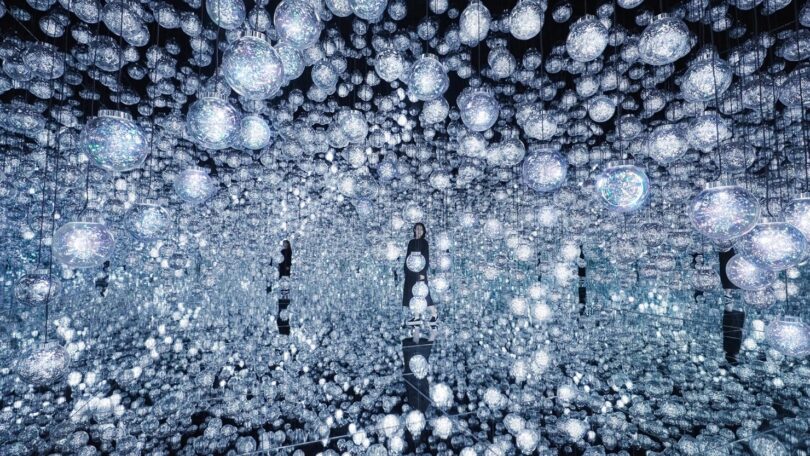TOKYO (CNN): When art collective teamLab opened its flagship Tokyo venue, teamLab Borderless, in 2018, the group wanted it to fundamentally change the way we perceive and think about modern art.
Whether it achieved this ambition is subjective, but it’s hard to argue with Borderless’ commercial success before it closed in 2022 to make way for a major redevelopment project. In its first year, the venue welcomed 2.3 million visitors, making it the world’s most-visited museum dedicated to a single artist, group or collective at the time.
The group’s second Tokyo space, teamLab Planets, is no slouch either, with Google naming it the world’s fifth most searched-for museum in 2023. The collective of self-described “ultra-technologists,” which includes artists, programmers, engineers, CG animators, botanists, mathematicians and architects, has also exhibited its works to great acclaim in cities including Beijing, Melbourne, New York, London, Singapore and Taipei.
So, it’s perhaps no surprise that a significant amount of hype surrounds the grand return of Borderless, which reopens this week in an upmarket new high-rise in Tokyo’s Azabudai district. Visitors can expect the familiar trappings of projection graphics, dynamic light shows and interconnected artworks that react to each other and change in accordance with the position and behavior of the viewer.
“Immersion” and “digital” are two words commonly used to describe teamLab’s exhibitions. But the two collective members who showed CNN around their new space ahead of its opening on Friday hardly ever reference these aspects of their work. Instead, talk turns to themes of the continuity and nature of time, the shortcomings of fixed-point perspectives and the boundary between artworks and the physical world. Digital technology is simply a tool for expression, they say — and immersion is a by-product of the artistic output.
A museum without a map
Takashi Kudo, teamLab’s communications director, epitomizes the group’s philosophical approach. During CNN’s tour, he sat monk-like in a hall of mirrors amid glittering head-sized lights, as though a cosmic infinity were stretching out before him.
“Twenty years ago, no one called us artists… People want answers, but the purpose of art is to keep asking more questions,” he said. “We want to think about — to create — a being society, not a having one. But how do you create a society where people don’t want things?”
Kudo’s rhetorical style is circuitous, which is apt in a venue that eschews a linear approach to museum design. But he never loses sight of the topic at hand.
“These lights are like nature,” he added, motioning to the glowing spheres around him as they reach a serene crescendo. “Sometimes when you’re in nature there are stimuli everywhere, almost too many stimuli, then everything comes together in perfect harmony. That experience is what we want to create. But it’s all about the process. That’s what makes it art.”
This particular room, “Bubble Universe” (pictured top) is technically one of several separate spaces within the museum. But while the psychedelic names attached to each artwork are memorable — “Microcosmoses” or “Infinite Crystal World,” for example — it’s easy to lose your way traveling between them. There is no prescribed route or methodology for experiencing them. It is a museum without a map. It is, in a word, “borderless.”
Wandering around Borderless is more like “shinrin-yoku,” the Japanese art of forest bathing, whereby you let your body react to its environment so that it subconsciously directs your movements. And there is plenty to react to.
One minute it’s projection-mapped floral bouquets that bloom when you touch them, or hordes of colorful butterflies born out of thin air as you lean against a wall. Soon you’re chasing spectral crows from one room to another or following a cavalcade of digital frogmen marching to the beat of their own drum. Water patterns swirl around your feet only to reappear as crashing waves in another location an hour or two later. The artworks interact with each other, too, meaning every day and every individual experience is entirely unique. It’s a series of “ichi-go ichi-e” (literally “for this time only”) moments — those that can never be repeated.
The museum strives to engage all five of your senses. Alongside the interactive visuals, fragrant scents and soothing soundscapes pervade each room. There’s also a teahouse, with deliciously layered yuzu green tea and green tea ice cream that initiate light projections when placed on the table.
There may be no centerpiece at Borderless, but when another teamLab member, Sakurako Naka, opened a curtain to the new “Light Sculpture” series, she said the collective is “super excited” about this one. The room uses mirrored panels and lights that flicker, jolt and swerve in unison to create hypnotic vortices in three dimensions.
“It’s amazing, right?” said Kudo. “I’ve seen this one maybe 200 times and it never gets old.”
Achieving all this is no easy feat — and it’s one that Kudo credits to the spirit of collaboration among the multidisciplinary collective’s many members (teamLab does not say how many people it counts among its constantly-changing ranks).
“We can’t do it with technology alone,” added Kudo. “It’s about working together as a team to create art and change people’s perceptions. And maybe with that we can help change the world.”







